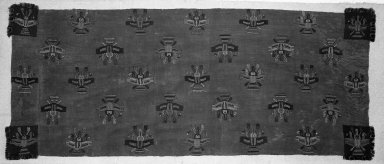
Artist:NascaParacas Necropolis
Medium: Camelid fiber
Geograhical Locations:
Dates:0–100 C.E.
Dimensions: 104 3/4 x 38 3/16 in. (266.1 x 97 cm)
Collections:
Accession Number: 34.1556
Image: 34.1556_acetate_bw.jpg,
Catalogue Description: Size: adult; probable wearer: male. Plain weave with horizontal camelid fiber warp, camelid fiber weft and camelid fiber embroidery. The mantle has a crimson ground with a pattern of large bird-like figures with outstretched wings repeated over the entire textile. Each corner has a black (purple) square border with fringe and one-faced crossed looping, and is embroidered using one-faced stem-stitch curvilinear embroidery to create a single bird figure. Green, yellow, blue, purple, white, khaki and pink colors are used for the figures on the borders and in the field (NK). There are four variants of the figures represented with a fifth figure type in one of the border sections. From Mary Frame's notes: The mantle does not appear to have had long borders; however, the fringe band may have originally extended across the long sides as it is cut at the relevant 4 interior points of the border squares. It is possible that the long borders were removed, or never attached. Two of the 34 bird figures in the field of the mantle are unfinished and lack hand-held ornaments, one of the figures holds only one ornament and the remaining 31 each hold two ornaments. The figure's body is bilaterally symmetrical; it is only the differing hand-held objects that make it asymmetrical. The rows and columns are arranged in translational symmetry and therefore rotational symmetry between the rows and columns. The lower right corner border contains an aberrant color block image. This figure type combines human attributes (arms and head) with the body of a bird (likely a falcon from the tail markings) shown in flight with its wings outstretched, representing the mythical transformation from human to bird. A snake-like protuberance extends from the mouth and two trophy head-like figures appear at either side of the snake. Two snakes adorn the bird's back. In the Museo Nacional de Antropologia y Arqueologia, Lima, Peru, bundle 310 contains a ponchito (41) with similar figures. This figure was called a "goat sucker" by Junius Bird, but Mary Frame refers to it as one stage in the mythical transformation from human to falcon. The mantle format, with corner blocks but no borders on the long sides, is not among the types diagrammed by Carrion-Cachet, 1931, figs. 14 and 15. It remains a possibility that its borders were carefully removed, or never attached. Two mantles in the Boston Museum of Fine Art (16.31 and 16.33) are in the same state.